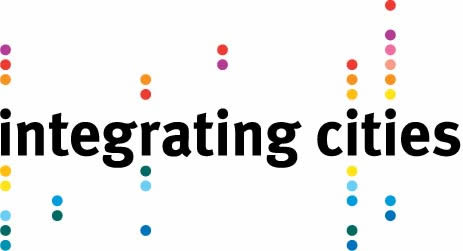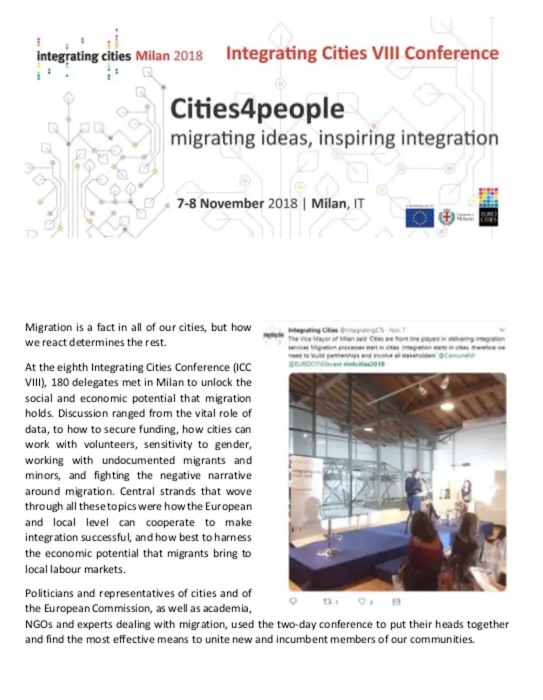At the Integrating Cities conference VIII, 180 delegates representing cities and public authorities, European institutions, NGOs and think-tanks, international organisations and the academia, met in Milan to unlock the social and economic potential that migration holds. This short conference overview gives a flavour of what the discussions were about.
USEFUL DOCUMENTS
READING MATERIAL FROM THE CONFERENCE
Data for integration – Studying local aspects of migration using a new dataset, Joint Research Centre
The Global Compact for migration – why it matters to cities; Dr Colleen Thouez, Open Society Foundation
About Milan and migration, City of Milan
Cities and Migrants, 3rd Integrating Cities implementing report; EUROCITIES
(click to open)
WORKSHOPS
Workshop 1: Labour market integration at local level: partnerships, strategies and practices for effective integration
The main conclusions of the discussion were:
- It is essential to gather data. This can help prepare the labour market to receive migrants, to understand the skills that they are bringing, and to understand the needs of local companies (and include this information in any training the city is providing).
- Economic data on the contribution of migrant work to the economy is also a great tool for changing attitudes.
- It is important to provide multiple services at the same location, and each service in several languages.
- Entrepreneurship, even though it has its own barriers, is a great solution. It resolves problems with the need for recognition of foreign qualifications, and the reticence that employers can feel about investing in people who might not get permission to stay or might want to move. It also has a greater benefit, because migrant entrepreneurs can also give employment to the incumbent population.
Presentations by: Milan (Angela Guma), Helsinki (Toivo Utso), Migrant Entrepreneurship Growth Agenda (MEGA) (Carlos Talamas)
Workshop 2: Promoting effective labour market integration of migrants and refugees – the OECD checklist for integration at local level
The main conclusions of the discussion were:
- The goals of labour market integration policies are to increase social cohesion and provide equal opportunities for all and to have a long-term perspective for migrants.
- Programmes should assess newcomers’ existing skills and consider their aspirations and capabilities (example of Rotterdam which gives newcomers an advisor to help create a life plan for the years to come – talents/skills, needs, life goals and then design training and matching to labour market needs).
- Projects should be ‘future proof’, so that newcomers build transferable soft and hard skills that can be valuable even if they are not allowed to stay in a particular Member State (example, English and entrepreneurship training in Utrecht’s Einstein Plan).
- Issues: 1) legal constraints (national rules regarding access to job markets, recognition of skills, availability of language and other skills training); 2) lack of finances (undermines sustainability of projects).
- Cities should use the tools at their disposal (e.g. cities act as employers and as providers of integration services, such as language training; cities are coordinators of relevant stakeholders and hold tools to matching newcomers with available jobs and programmes). Cities should not hesitate to enter partnerships with different stakeholders (NGOs, job centres, associations of employers, vocational training providers, national ministries for social security/health/education, etc.)
Presentation by: OECD (Anna Piccinni)
Workshop 3: Minors of migrant background in cities: challenges and good practices for integration
The main points of the discussion were:
- When it comes to unaccompanied minors, it is a challenge not to focus only on emergency measures, but also on long-term integration – there needs to be a continuation line (in project and policy sense) that follows and supports the youngsters from reception to inclusion.
- Another challenge concerns those unaccompanied minors who turn 18 shortly after their arrival – support for them should not stop as soon as they turn 18. One answer could be to provide immediate, short and tailor-made training programmes for this group of youngsters so that they can acquire some skills and that they can more easily integrate other programmes once they turn 18.
- Partnerships – public/private, also with NGOs – have an important role to play in this field (example of the new reception centre for unaccompanied migrants in Milan). Emphasis should be placed on longer-lasting project as they can better demonstrate the impact of such partnerships.
Presentations by: Milan (Barbara Lucchesi), Save the Children (Valentina Polizzi)
Workshop 4: Solidarity Cities initiative
The main points of the discussion were:
- Cities can be key actors for reception of refugees (examples of Athens and Milan). They are able to assess and meet the needs of asylum seekers and refugees.
- What are the reasons for the SCi’s limited impact?
- Limited cooperation with national governments (blocking the cities’ pledge for relocation of refugees from the receiving cities);
- Lack of funding for social investments;
- Housing shortages;
- Little solutions for those in vulnerable situations or in limbo status (undocumented).
- What are the needs of cities in order for the SCi to be more effective?
- Better communication of the existing initiatives in cities which could be transferred;
- Better cooperation with the national level;
- More financial means, and direct access to EU funds;
- Involving more NGOs which can better signal possible solutions for vulnerable groups.
Presentations by: Athens (Eleftherios Papagiannakis), Milan (Antonella Colombo)
Workshop 5: Funding & partnerships for integration in cities: innovative schemes and better access to EU funds
This workshop addressed three main questions:
- Why does the partnership approach increase chances to access funding?
- It increases capacity to apply for projects, as each partner brings different (ideally complementary) competences and skills.
- It increases the multilevel approach.
- A heterogenous multi-stakeholder partnership enables access to a wider range of grants, thus maximising the chances of accessing funding.
- What are the success factors of the partnership approach to integration?
- You have to listen to all your partners: it is important to have a Memorandum of Understanding, so that everyone understands the rules, limits, objectives and motivations of each partner.
- Achieving an agreed and shared vision of the partnership – clarity of roles, clarity of objectives.
- Level-playing field and balance among the partners – each partner should be able to shape the partnership.
- What are the challenges of the partnership approach to integration?
- Financial limitations (e.g. limited cashflow of smaller organisations).
- Different working cultures (e.g. civil servants and NGOs) which can bring to competition and misunderstanding – some partners (e.g. private sector) do not easily see the advantage of partnering with public institutions.
- Complicated procurement rules – limited time for building a partnership.
- High-level buy-in from the leadership entails a risk in that initiatives can collapse when the political leadership changes.
- Who has ownership of the project in a partnership?
Presentations by: Rotterdam (Rob Gringhuis), European Investment Bank (Patricia B. Llopis)
Workshop 6: Role of volunteers and civil society organisations for integration in cities – public sector/civil society partnership
The main points of the discussion were:
- Two important questions when it comes to civil society organisations as partners of the cities: 1) Who are they? Often, they include both big and small organisations, focusing on different areas and with diverse degrees of professionalism (the latter can also be a concern); 2) And how to ensure that the city has an overview of what is happening locally? Coordination is thus an important tool, also for building ‘networks of networks’.
- These organisations have an important role to play in signalling issues, in creating dialogue, and in delivering services, especially in emergency situations.
- Problems encountered: 1) contribution of a particular organisation is often short-term, another organisation substitutes its work – lack of continuity; 2) funding – need for transparency but also inevitably need to rely on the private sector and foundations where possible.
- Conclusion: emergency as an opportunity to build community of practices, and to create processes that will become part of the normal procedures.
Presentation by: Athens (Eleftherios Papagiannakis)
Workshop 7: Gender and migration – integration of women migrants
The main points of the discussion were:
- Many challenges to integration of women migrants: high levels of social exclusion, many highly qualified migrant women with little job opportunities, very diverse group of (migrant) women, frequent mismatch skills-jobs, perceptions of ‘working mothers’ among the migrant community.
- Possible ways forward:
- Have intermediary ‘benchmarks’ or ‘milestones’ on the integration path measuring if women are taking language courses or if children are going to school/kindergarten?
- Increase participation of refugee/migrant women to tailor city integration strategies according their needs.
- Provide training on project-writing skills for community organisations so that they can apply for small funding to support women integration.
- Provide information on anti-discrimination as often women/men do not know what discrimination is.
- Importance of partnerships between cities/NGOs/businesses.
- Spread the system of ‘neighbourhood mothers’ (whereby mothers with long-term immigrant experience reach out and help the newly arrived immigrant mothers).
- Improve gender equality in the host society as a whole since gender gap in integration is often a reflection of the gender gap in the host society.
Presentations by: Vienna (Karin König, Moujan Wittmann-Roumi Rassouli), Helsinki (Anu Riila)
Vienna, Gender and Migration
Karin König, Moujan Wittmann-Roumi Rassouli
Vienna, CORE project
Karin König, Moujan Wittmann-Roumi Rassouli
Workshop 8: Undocumented migrants: possible solutions to ensure access to services
The main conclusions of the workshop discussion were:
- Create workarounds for working with migrants – build synergies with other local organisations and direct measures not just towards migrants but towards all vulnerable members of the society. Local registration is a practical tool that can empower cities (example of Barcelona, where undocumented migrants can access services with city registration).
- Cities are always problem-solving, they don’t give services for their own sake – cities come up with innovative solutions such as local registration, shelter, access to legal advice and safe reporting mechanisms that solve practical problems.
- You need solidarity and strong leadership – cities need strong leaders who work together to present a unified voice to the national level. Using a network of European contacts and NGOs can exert greater pressure to further the cause of undocumented migrants.
Presentation by: Utrecht (Jan Braat)














